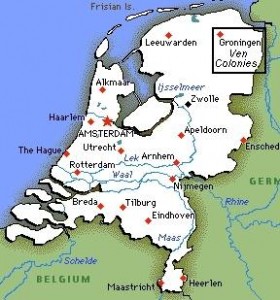Introduction

Location of the Ven Colonies.
In the north of the Netherlands, in the province of Groningen, is an area called ‘De Veenkoloniën’ (The Ven Colonies or Peat Colonies). This area once provided the main energy source of the Dutch Golden Age: peat. During the period between the beginning of 16th trough the start of the 20th century the peat moors were drained and cut away. In the second half of the 19th century the peat in the Veenkoloniën was almost gone1. What remained was a unique landscape dominated by huge fields and straight canals. This landscape formed the foundation for the agricultural industry that emerged in the second half of the 19th century, with potato starch and strawboard as their main products.
The emergence of the agricultural industry in the Groninger Veenkoloniën caused a quite serious problem: one of the worst episodes of industrial water pollution in the Netherlands. This gave the Veenkoloniën the negative image of a region with filthy and stinking canals, being the concern of the industry, government and population for more than a century. Continue reading


Recent Comments